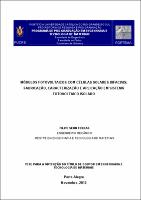| Share record |


|
Please use this identifier to cite or link to this item:
https://tede2.pucrs.br/tede2/handle/tede/3221| Document type: | Tese |
| Title: | Módulos fotovoltaicos com células solares bifaciais : fabricação, caracterização e aplicação em sistema fotovoltaico isolado |
| Author: | Febras, Filipe Sehn  |
| Advisor: | Moehlecke, Adriano |
| Abstract (native): | O objetivo principal deste trabalho foi fabricar e caracterizar módulos fotovoltaicos concentradores estáticos (MEC-P) com células solares bifaciais e refletor difuso. Módulos fotovoltaicos concentradores e módulos convencionais com a mesma área de células foram instalados em sistemas fotovoltaicos isolados por aproximadamente 1,5 anos e os mesmos foram caracterizados eletricamente após o período de exposição à radiação solar. Os sistemas fotovoltaicos foram monitorados, medindose a irradiância (total e ultravioleta) no plano dos módulos, a tensão do banco de baterias, a corrente elétrica na carga, a tensão e a corrente elétricas dos módulos fotovoltaicos. Dois módulos fotovoltaicos concentradores foram construídos com as dimensões de 775 mm x 690 mm x 70 mm (comprimento x largura x espessura) e com 36 células solares bifaciais de 80 mm x 80 mm, soldadas em série. Com células cuja eficiência média foi (13,8 ± 0,2) % e (13,2 ± 0,2) % para iluminação pela face frontal e posterior, respectivamente, fabricou-se um módulo com eficiência igual a 7,8 %. Com células de (13,7 ± 0,2) % / (13,1 ± 0,3) % para iluminação frontal/posterior, a eficiência alcançada pelo módulo foi de 7,6 %. Estimou-se que a temperatura das células solares nos módulos concentradores foi da ordem de 5 ºC a 9 ºC maior que a de células solares em módulos convencionais com o mesmo tipo de vidro e materiais de encapsulamento similares. Os módulos concentradores foram submetidos à radiação total de aproximadamente 1,9 MWh/m2 (6,84 x 109 J/m²) durante 1,5 anos e não apresentaram nenhuma degradação de seu aspecto visual bem como de suas características elétricas. O sistema fotovoltaico isolado instalado com módulos MEC-P apresentou uma eficiência média mensal de (6,5 ± 1,0) % no período em que a carga foi mantida constante. A eficiência de 1 % abaixo da obtida com os módulos MEC-P foi devida à maior temperatura de operação, a maior refletância da radiação solar quando os módulos são instalados no plano inclinado e há variação do ângulo de incidência durante o dia, às perdas resistivas no sistema e porque no cálculo da eficiência do sistema foi considerada a energia elétrica produzida e armazenada. |
| Abstract (english): | The main objective of this work was to fabricate and to characterize static concentrator photovoltaic modules (MEC-P) with bifacial solar cells and diffuse reflector. PV concentrator modules and PV standard modules with the same solar cell area were installed in a stand-alone PV system at 1.5 years and these were electrically characterized after the solar radiation exposure. The PV systems were monitored, measuring the irradiance (total and ultraviolet) at the same plane of PV modules, the voltage of battery, the electric current to the load and the electrical voltage and current of PV modules. Two PV concentrators were manufactured with dimensions of 775 mm x 690 mm x 70 mm (length x width x thickness) and with 36 bifacial solar cells with 80 mm x 80 mm, soldered in series. With cells whose average efficiency was (13.8 ± 0.2) % and (13.2 ± 0.2) % for front and rear mode illumination, respectively, one module with efficiency of 7.8 % was fabricated. By using solar cells of (13.7 ± 0.2) % / (13.1 ± 0.3) % for front / rear illumination mode, the efficiency achieved by the PV module was 7.6 %. It was estimated that the temperature of the solar cells in PV module concentrators was about 5 °C to 9 °C higher than that of PV standard modules with the same type of glass and similar lamination materials. The PV concentrators were subjected to total radiation of around 1.9 MWh/m² (6.84 x 109 J/m²) for 1.5 years and presented no degradation of their visual appearance as well as its electrical characteristics. The PV stand-alone system installed with MEC-P modules showed a monthly average efficiency of (6.5 ± 1.0) % in the period in which the load was held constant. The efficiency was 1.0 % lower than that obtained with the modules MEC-P was due to the higher operating temperature, the higher reflectance of solar radiation when the PV modules are installed on the tilted plane and has variation of the angle of incidence during the day, the resistive losses in the system and because in the calculation of system efficiency it was considered the electrical energy produced and stored. |
| Keywords: | ENGENHARIA DE MATERIAIS CÉLULAS SOLARES SISTEMAS FOTOVOLTAICOS |
| CNPQ Knowledge Areas: | CNPQ::ENGENHARIAS |
| Language: | por |
| Country: | BR |
| Publisher: | Pontifícia Universidade Católica do Rio Grande do Sul |
| Institution Acronym: | PUCRS |
| Department: | Faculdade de Engenharia |
| Program: | Programa de Pós-Graduação em Engenharia e Tecnologia de Materiais |
| Citation: | FEBRAS, Filipe Sehn. Módulos fotovoltaicos com células solares bifaciais : fabricação, caracterização e aplicação em sistema fotovoltaico isolado. 2012. 126 f. Tese (Doutorado em Engenharia e Tecnologia de Materiais) - Pontifícia Universidade Católica do Rio Grande do Sul, Porto Alegre, 2012. |
| Access type: | Acesso Aberto |
| URI: | http://tede2.pucrs.br/tede2/handle/tede/3221 |
| Issue Date: | 26-Nov-2012 |
| Appears in Collections: | Programa de Pós-Graduação em Engenharia e Tecnologia de Materiais |
Files in This Item:
| File | Description | Size | Format | |
|---|---|---|---|---|
| 444963.pdf | Texto Completo | 9.37 MB | Adobe PDF |  Download/Open Preview |
Items in DSpace are protected by copyright, with all rights reserved, unless otherwise indicated.




